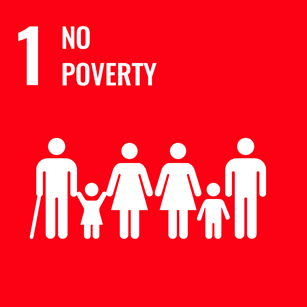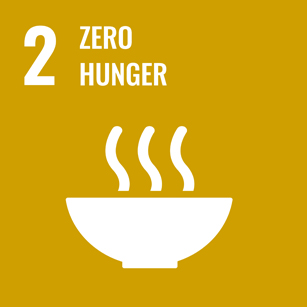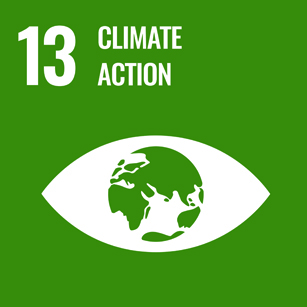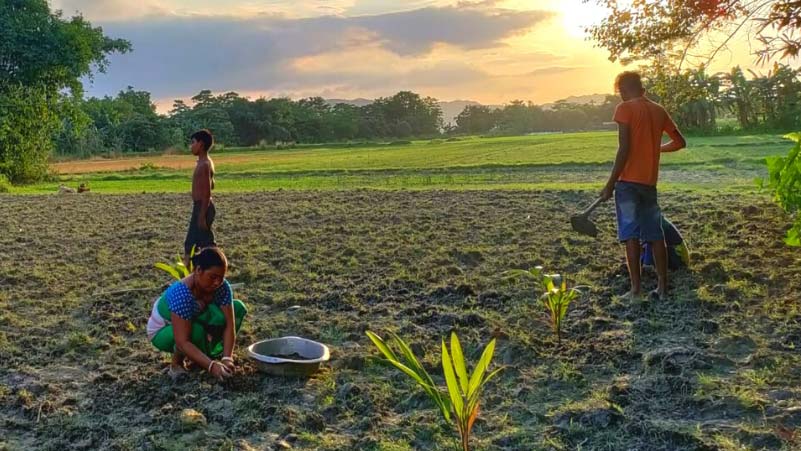Regenerative agriculture and afforestation in the rural Northeast
- Proposed areas of implementation
- Potential areas of implementation
Project Partner



The North Eastern Region (NER) of India is one of the most ecologically diverse regions, encompassing a spectrum of habitats such as alpine scrubs, tropical rainforests, and flood plains. It is also a mega biodiversity hotspot, supporting over 8000 flora species (32% are endemic), and is home to rich faunal diversity. About 60% of NER’s geographical area (i.e., approximately 17.04 million hectares) is covered by forests. However, the forest cover and the biodiversity it supports are under threat. The decline in forest cover and biodiversity can be attributed to several primary factors, including increased encroachment, urbanisation, and shifting cultivation. Afforestation initiatives have been limited, and the ones that have been undertaken have focused mainly on monocropping plantations, leading to reduced genetic and species diversity, and increased pollution through the use of chemical fertilisers and pesticides.
In response to these pressing issues, Seven Sisters Development Assistance (SeSTA) aims to establish community-based models of regenerative agriculture and afforestation efforts in blocks of three districts of Assam and two districts of Tripura, leveraging the communities’ strong association with forests and natural resources. These districts represent remote rural pockets predominantly inhabited by marginalised communities, including Scheduled Tribes (STs), Scheduled Castes (SCs), Adivasis, and other ethnic minorities. Women’s community institutions will play a central role as drivers of climate change action. The project seeks to enhance community resilience against the perils of climate change and contribute to climate change mitigation.
Spanning three years, this project will lay the foundation for extensive work in the region focused on climate change resilience and mitigation through multi-sectoral collaboration in the future. Within each block, the project will engage with 3,000 women across 50 villages, positively impacting the lives of 15,000 people.
Context
The North Eastern Region (NER) of India comprises eight states: Arunachal Pradesh, Assam, Manipur, Meghalaya, Mizoram, Nagaland, Sikkim, and Tripura. The region has a population of approximately 46 million, with a density of 173 persons per square kilometer. The population is ethnically diverse, with over 140 tribal communities. More than 70%, or 32 million people, reside in rural areas; and agriculture and allied activities, such as animal husbandry, poultry, fishing, and collection of non-timber forest produce, are the main occupation and source of income for communities in the region. Most families are small and marginal farmers, owning less than 2 hectares of land.
Assam and Tripura are the two proposed states for the project. Assam, located in the foothills of the eastern Himalayas, is the largest state in the NER in terms of geographical area, with nearly half of the population engaged in agriculture and allied activities. The tea industry and other natural resource-based industries, such as bamboo-based artifacts, muga silk, and paper, play vital roles in the state’s economy. Tripura is predominantly a hilly region largely surrounded by the deltaic basin of Bangladesh. Like Assam, most people in Tripura depend on agriculture and allied activities, contributing to about 64% of total employment.
The NER is known for its remarkable ecological diversity, encompassing various habitats such as alpine scrubs, tropical rainforests, and flood plains. It is also a mega biodiversity hotspot, supporting over 8,000 flora species, with 32% being endemic. The region is home to rich faunal diversity, including several endangered species. Forests cover approximately 60% of the geographical area of the NER, accounting for around 17.04 million hectares. However, both the forest cover and the biodiversity it supports are under threat. Between 2019 and 2021, the NER witnessed a decline of about 1,020 square kilometers of forest cover, with a total decline of about 25,000 square kilometers in the last decade alone. Increased encroachment, urbanisation, and the practice of shifting cultivation are among the primary reasons for this decline. Afforestation initiatives have been limited, and the ones that have been undertaken have often focused on monocropping plantations, resulting in reduced genetic and species diversity, and increased pollution through chemical fertilizers and pesticides.
Climate change has further exacerbated the challenges faced by the NER, including altered rainfall patterns and increased temperature variability. The region has experienced lower-than-normal rainfall in 19 years between 2001 and 2021, despite receiving three-fourths of its annual rain during the monsoon season. This has resulted in increased extreme rainfall events, affecting river flow and causing devastating floods; and this has been followed by long dry spells. Assam is considered the most climate-vulnerable state in India, while Tripura ranks 19th in terms of vulnerability. The districts of Dhemaji, Dhubri, Dibrugarh, Lakhimpur (Assam), and West Tripura (Tripura) are particularly susceptible to extreme floods, experiencing a significant increase in the frequency of flood events since 2010.
Agriculture, the primary livelihood for a large proportion of the population in Assam and Tripura, is adversely affected by these temperature and rainfall fluctuations. However, the agriculture sector also contributes to climate change through greenhouse gas (GHG) emissions, such as nitrous oxide and methane, as well as loss of carbon sink due to the conversion of forest land into agricultural land. Without effective mitigation and adaptation measures, GHG emissions from the agriculture sector are likely to increase, given the trend of increased usage of chemical fertilizers, pesticides, and large-scale soil disturbance.
The remote rural areas proposed in this project have a majority of marginalised communities, including Scheduled Tribes, Scheduled Castes, Adivasis, and other ethnic minorities, who have traditionally maintained a symbiotic and sustainable relationship with the forest ecosystem. Unfortunately, this relationship has destabilised in recent decades due to deforestation caused by illegal logging and agricultural expansion. These communities are highly vulnerable to climate change, with multidimensional vulnerabilities and limited capacities and opportunities. Women within these communities face inequalities in terms of resource access, skills, and opportunities, leading to the feminisation of poverty. Despite these concerns, there has been limited concentrated action to support and empower communities in building resilient livelihoods that integrate climate action.
SeSTA has been actively working to mitigate climate change impacts and build community resilience by promoting climate-friendly solutions such as establishing seed banks, facilitating access to quality organic inputs, and promoting agro-ecological practices. The organisation has collaborated with various stakeholders to bring about systemic changes in the community, and the community institutions developed by SeSTA are well-positioned to intensify their operations to address climate change issues.
Building on the learning of previous experiences, this project aims to establish community-based models of regenerative agriculture and afforestation efforts in five districts of Assam and Tripura, leveraging the communities’ strong association with forests and natural resources. Women’s community institutions will play a central role as drivers of climate change action. The project seeks to enhance community resilience against the perils of climate change and contribute to climate change mitigation.





Problem statement
The project is actuated by four distinct problems faced in the states of Assam and Tripura.
Assam witnessed a rise in mean temperatures from 1950-2010, with pronounced warming in post-monsoon and winter temperatures. While annual rainfall decreased over the same period, there has been a significant increase in extreme precipitation events, resulting in flash floods. Districts in central Assam Valley and adjoining parts of Karbi Anglong (one of the proposed districts for the project) are rain-shadow zones with rainfall between 800-1200 mm. Water scarcity, poor irrigation systems, and lack of water harvesting practices further worsen the situation for communities in the region. Concerningly, rainfall in this zone is slowly decreasing, and the water crisis is expected to aggravate in the coming years. Climate projections for 2021-2050 indicate a likely increase in mean temperature by 1.7 – 2.0 degrees Celsius. Rainfall is projected to decrease by 5% in the western districts (e.g., Kokrajhar, one of the proposed districts for the project) and increase across the rest of Assam (e.g., Morigaon and West Karbi Anglong, the other two proposed districts). Projections also indicate an increase in extreme rainfall events and subsequent floods (by about 25% in the southern districts). For Tripura, an analysis of data from 1951-2013 shows an increase in average maximum and minimum temperatures, reduction in rainfall in districts of Dhalai, Khowai, North Tripura, South Tripura, Gomati, and Unakoti, and an increase in rainfall in Sepahijala (a proposed intervention district). Climate projections for 2021-2050 indicate increasing temperatures and rainfall ranging between 4-13% across all districts
Agriculture accounts for about 20% of global GHG emissions. The Third Biennial Update Report submitted by the Government of India (GoI) in 2021 to the United Nations Framework Convention on Climate Change (UNFCCC) states that the agriculture sector contributed 14% to total GHG emissions. Within the sector, 54.6% of emissions are due to enteric fermentation, 19% from fertilizer applied to agricultural soils, 17.5% from rice cultivation, 6.7% from manure management, and 2.2% due to field burning of agricultural residues. Approximately 75-80% of the total nitrous oxide gas emitted comes from chemical fertilizers. SeSTA’s field experience shows varying levels of chemical inputs usage among farmers, ranging from relatively high in Karbi Anglong to relatively low in the two districts of Tripura (see Table 1 for details).
Table 1 – Use of chemical inputs in agriculture
| STATE | DISTRICT | GEOGRAPHICAL AREA (SQ. KM) | NATURAL FOREST COVER15 (%AGE) | COMMON LANDS | AGRICULTURE TYPE IN PERCENTAGE | ||
|---|---|---|---|---|---|---|---|
| HIGH CHEMICAL USAGE | MODERATE CHEMICAL USAGE | LOW OR NEGLIGIBLE CHEMICAL USAGE | |||||
| Assam | Karbi Anglong | 10,434 | 73% | Available | 50% | 30% | 20% |
| Kokrajhar | 3,129 | 28% | Available | 60% | 40% | ||
| Morigaon | 1,704 | 6% | Available | 30% | 50% | 20% | |
| Tripura | Dhalai | 2,312 | 74% | Available | 20% | 50% | 30% |
| Sipahijala | 1,043 | 31% | Available | 15% | 60% | 25% | |
Reducing emissions from agriculture is crucial and requires the adoption of new climate-smart, regenerative practices, and technologies. However, transitioning away from chemical-intensive agriculture is a gradual process that unfolds over 4-5 years, and farmers need capacity building support during this period.
The states lack climate change-resilient farming (CRF) models that can simultaneously generate sustainable livelihoods for farmers, aid in adapting to climate change, and mitigate agriculture’s contribution. There is an urgent need to adopt climate-resilient livelihood models using an ecosystem-based approach. These models encompass various strategies such as agro-ecology development, life-cycle-based micro-water resource harvesting, conservation practices to enhance soil organic carbon content, transition to organic fertilizers and pesticides, effective nutrient and manure management, cultivation of climate-tolerant crop and livestock breeds, and improved feed management. Implementing these measures will contribute to long-term higher productivity and farm incomes, even in the face of climate variability. A critical component of CRF is agroforestry, which includes agri-horticulture , a land use system that combines fruit trees and and field crops to enhance productivity, profitability, diversity, and ecosystem sustainability.
Special attention has been given to women-led CRF models in action research. Women, who already face precarious livelihood situations, are particularly vulnerable to the worsening impacts of climate change. Despite their significant contributions in terms of time, labor, and knowledge in agriculture, which have only increased with escalating rural-urban migration by men, women are predominantly identified as agricultural laborers. They lack access to the necessary resources for profitable farming; such as inputs, services, finance, and markets. Further, gender norms restrict their ownership of productive assets and participation in decision-making. The Food and Agriculture Organization (FAO) estimates that if women had the same access to productive resources as men, farm yields would increase by 20-30%, adding 2.5-4% to total agricultural output in developing countries. Therefore, there is a need to design community institutions for and by women that can serve as empowerment pathways for women farmers to transition from laborers to leaders in agriculture.
Recognizing the significance of community institutions in promoting integrated sustainable development for the poor and marginalized, the Deendayal Antyodaya Yojana-National Rural Livelihood Mission (DAY-NRLM) was established in 2016. This initiative focuses on establishing self-help groups (SHGs) as community institutions, preferably led by women from households. At the village level, clusters of SHGs are federated into Village Organizations (VOs) to provide space, voice, and resources for the community. The objective of DAY-NRLM is to drive social mobilization, financial inclusion, and livelihood promotion.
However, SeSTA’s experience of working with SHG platforms has highlighted two challenges. Firstly, the current focus of the State Rural Livelihood Missions (SRLMs), including the District Mission Management Unit (DMMU) and Block Mission Management Unit (BMMU), primarily revolves around diversification and strengthening of livelihoods through access to formal credit and entitlements. The importance of building and strengthening livelihoods in the context of a changing climate, such as through Climate Resilient Farming (CRF) models, has not yet been fully integrated into the fabric of the SRLM. Secondly, although NRLM/SRLM theoretically aims to converge with various schemes (e.g., NRLM and MGNREGS) and stakeholders (ministries, agencies at national, state, district, block levels, and civil society organizations), the implementation of such convergence has been inadequate in reality. As a result, investments from government schemes to build resilience in communities have been hampered.
Hence, there is a crucial need to collaborate with stakeholders and foster a collaborative spirit to integrate a climate lens into the efforts of DAY-NRLM and SRLMs. This would involve ensuring that climate-resilient practices, including CRF models, become an integral part of livelihood development initiatives. Additionally, fostering effective convergence between various schemes and stakeholders would facilitate greater investments in building community resilience.
This project aims to address these four issues by focusing on community-based models of climate-resilient farming, also referred to as regenerative agriculture models.
SeSTA has been working in the North East Region (NER) for over a decade, focusing on integrated natural resource management (INRM), community-based institutions, gender empowerment, and building resilience among marginalised communities through various programs and ensuring their access to entitlements and services. Over the past few years, SeSTA has started addressing these issues through a climate change lens. Extensive conversations with communities in the NER, specifically in Assam and Tripura, have revealed that while communities can articulate changes in weather patterns, they lack understanding of the broader issue of climate change and how it affects their livelihoods. There is also a need to help communities understand how chemical-based agriculture contributes to climate change and provide scientific rigor to traditional practices in remote villages engaged in chemical-free agriculture, which can increase income.
Goals and objectives
The goal of the project is to establish women-led community-based models of regenerative agriculture and afforestation that will restore degraded farmlands and enhance agrarian livelihoods, while simultaneously contributing to climate change adaptation and mitigation in three districts in Assam and two in Tripura.
Specific objectives of the project include:
(with primarily women members of SHGs and VOs) that will act as vehicles to drive ‘prototypes’ or models that strengthen livelihoods for enhanced incomes, help communities adapt to climate change, and help mitigate the effects of climate change.
Contribution to climate adaptation and mitigation
- Regenerative agriculture, a subset of climate-resilient farming (CRF) methods, supports farmers to transition from chemical-based agriculture to zero chemical/chemical-free practices. This support includes adopting a Package of Practices (PoP) that emphasises soil and water conservation and nutrient and manure management. CRF helps farmers adapt to climate change by restoring soil fertility and mitigates agriculture’s contribution to climate change through reduced use of synthetic fertilizers and improved nutrient management, leading to low carbon footprint agriculture.
- Promotion of agri-horticulture, which is a system of agroforestry, on individual lands (private property) and forestry on common land (community-owned) will contribute to climate adaptation and mitigation. Agroforestry builds resilience to climate change-induced effects such as droughts, floods, and strong winds by providing shade to crops, reducing soil erosion, and offering protection through the canopy of trees and shrubs. It also helps mitigate climate change effects by moderating microclimates, conserving natural resources in the short run, and sequestering carbon in the long run. Additionally, agroforestry systems typically require less synthetic fertilizer use compared to conventional agriculture, thus reducing direct emissions of nitrous oxide (N2O), a potent greenhouse gas.
Improved farm incomes and livelihoods
- Regenerative agriculture improves productivity and production while significantly reducing input costs for farmers.
- By bringing new production techniques and scientific rigor to traditional organic farming practices, productivity and production can be further enhanced.
- Income diversification can be achieved through promotion of agri-horticulture and through non-timber-forest-produce from the afforestation efforts.
Improved collaboration and convergence across multiple stakeholders
- Integrated Natural Resource Management (INRM) planning ensures the sustainable use of natural resources.
- Strengthening the Gram Panchayat Development Planning (GPDP) involves enhancing the technical capabilities of local stakeholders, Panchayati Raj Institutions (PRIs), etc., and linking INRM planning to GPDP planning. This complementary planning approach strengthens the overall local biodiversity of the region.
- Functional linkages with stakeholders and line departments are established to leverage resources and create an environment of co-creation around the building of climate change-resilient livelihoods.
About the organisation
Seven Sisters Development Assistance (SeSTA) empowers communities in remote rural areas of Northeast (NE) India by initiating rural development initiatives together with the villagers. SeSTA was conceived to put systematic effort towards the socio-economic development of NE by building capabilities of poor communities, promoting and strengthening their institutions to facilitate them out of poverty.
SeSTA works with 70,000 women and as many families in 2120 villages spread across 24 districts and 42 blocks in three States (Assam, Meghalaya and Tripura). It supports women from poor and marginalized households by skilling them on scientific agricultural interventions in food crop and vegetable crops, orchards, Natural Resources Management (NRM) and supporting the intensification and diversification of other livelihoods prospects such as goat rearing, piggery, fisheries, mushroom cultivation.
SeSTA is the technical support partner for the State Rural Livelihoods Mission in Arunachal Pradesh, Nagaland and Mizoram, in addition to being a direct engagement partner in Assam, Meghalaya and Tripura. The organization has received support from renowned agencies in the development space in India including Tata Trusts, Azim Premji Philanthropic Initiative (APPI), IndiGo (CSR- IndiGo Airline), National Bank for Agriculture and Rural Development (NABARD), UNICEF, UNDP, ITC CSR, LIC Housing, Cairn Foundation CSR.






